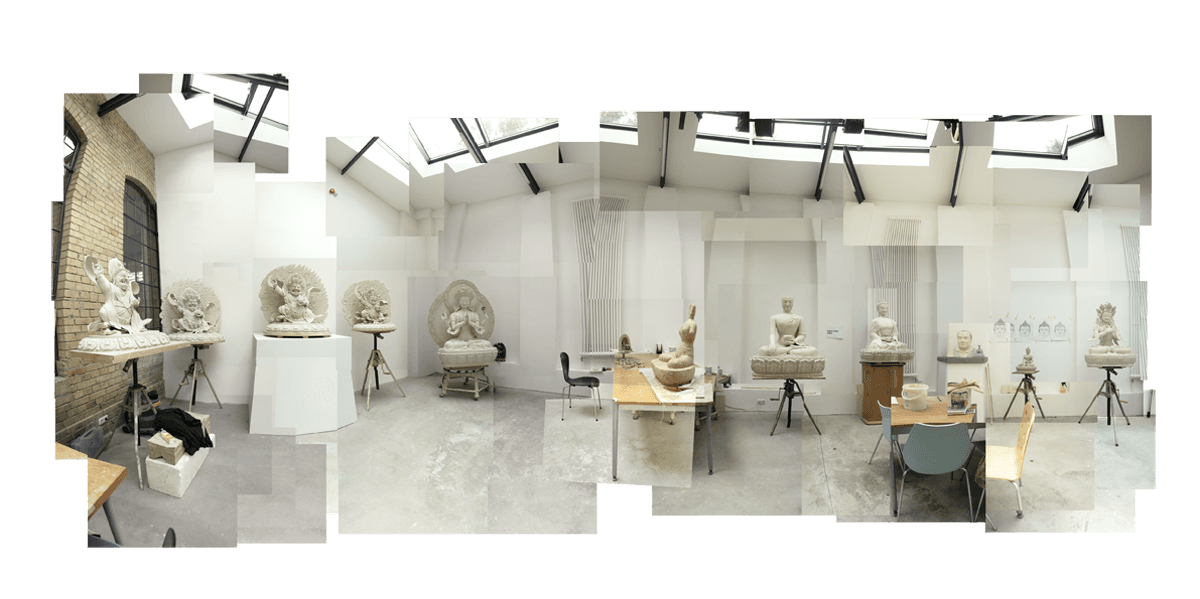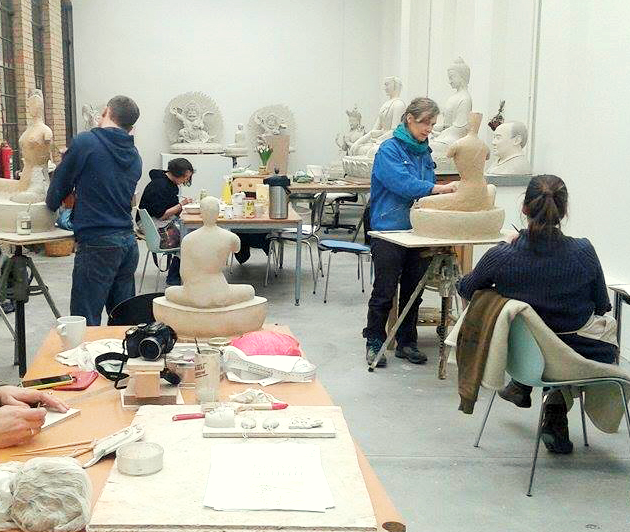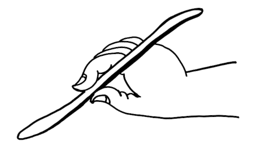
Buddhist Institute of Tibetan Art
The Buddhist Institute of Tibetan Art, called BINTA for short is collecting informations and providing knowlegde of Tibetan Buddhist Art.
BINTA is located in the Diamond Way buddhist centre in Brunswick, Germany.
Since 2006 knowledge of clay statue building and painting has been passed on to western students by recognized masters.
In October 2015, Lama Ole Nydahl gave permission to build statues for the Diamond Way Buddhist centers and asked his students to organize a school to learn skills of building and painting in traditional buddhist way.
Statues and thangkas (scroll paintings) are inseparable from Tibetan Buddhism. The varied Buddha forms are useful to recall the Buddha aspects during meditation. These cause responses in our mind. To make statues and thangkas work, they have to be produced in accordance to defined standards and they need to possess attributes that are described in the meditation instructions. For their transmission experienced masters are needed.
”You can´t build Buddhist statues just like that - without transmission”- Hannah Nydahl told us in 2006.
”If you really want to do sound work, if you want it to be big, you need transmission, a master who is in a secured tradition.”
Along with the practical work on statues, we collect texts, books and doctoral theses and exhibition catalogues about traditional Buddhist art. An archive composed of photographs, statues and documentations of the technique of building statues is planned in the long run.
Additionally, we give lectures about the history and technique of building clay statues.
School
Since 2010 Chhemet Rigzin has come to Brunswick each year to build statues in the Tibetan/Ladakhi tradition in consultation with Lama Ole Nydahl and to teach statue building to Diamond Way practitioners from around the world. The courses that we provide anable students to build the various Buddha aspects and learn the assosiated iconometry and iconography according to the tradition.
We continuously offer courses in which one can get a sense of the tradition of building clay statues that goes back now for more than a thousand years. Meanwhile we have elaborated a curriculum together with statue building masters.
In Ladakh, this education lasts between 6 to 17 years while working intensively with the master daily. During the education, the students draw and model over several years.
(the duration is due to the student´s capacities and personal input, also one might have to remodel a certain form time and again).


The following Buddha forms have already been built under our teacher´s guidance:
- Buddha Shakyamuni,
- White Liberatrice (tib.: Dolkar; sansk.: Sitatara)
- Green Liberatrice (tib.: Dolmar; sansk.: Shyamatara)
- Black Coat (tib.: Bernagchen; sansk.: Mahakala)
- Loving Eyes (tib.: Chenrezig; sanskr.: Avalokitesvara)
- Guru Rinpoche (tib. ; sanskr.:Padmasambhava)
- Milarepa, Marpa
- 16th Karmapa Rangjung Rigpe Dorje
Every year we organize courses in the workshop. Participation in an introductory course is required.
Research
Statues are an important aspect of Diamond Way Methods. In addition to the well-known metal statues from Nepal, clay statues are also widespread throughout the Himalayan areas of Bhutan, Tibet and Ladakh. The main aspects of Buddhist meditations have been created out of clay directly in the monasteries for more than 1,000 years.
Clay statues, as stated by Lama Ole Nydahl in Brunswick in 2015, “Our methods and material are that of Tibet”. The art of making clay statues has a long tradition. The specialized library for Traditional Buddhist art contains valuable books on Buddhist art, exhibition catalogues, as well as doctoral thesis and publications on this subject.
There is a dissertation about the clay statue construction in Ladakh and Brunswick written by Petra Förster
”Buddhistischer Lehmstatuenbau in Ladakh”
The production of the clay statues in Brunswick is documented and archived. In this way the knowledge about clay statue making and its tradition is preserved in a long term.
